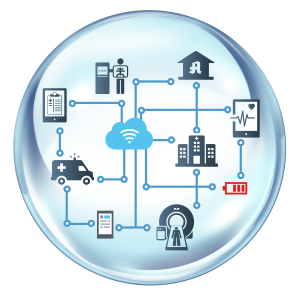The idea behind the Internet of Things (IoT) is that everyday objects can connect to each other and exchange data via the Internet. Even the smallest components, such as sensors for measuring temperature, angle of inclination or acceleration can send information or accept commands via the network. Current and future systems are based on the Internet protocol and will probably soon include ipv6 support. They transmit data in an open and well-known format. Depending on the application, data will most likely be transmitted via public networks. This means that data is in principle open to everyone who is connected to the network. Subject to the type of data the consequences range from unpleasant to catastrophic, which is why confidentiality must be protected and safeguarded. There are many ways of achieving this, especially through encryption. Current smartphones which are also part of the Internet of Things are technically capable of encrypting data connections. However, the majority of IoT components that will probably come in the future may not necessarily have the computing power, operating system and applications to establish an encrypted connection.
This is not a good reason for dismissing secure connections. Increasing numbers of cases have been reported where controls and sensors in both private and industrial areas have been compromised via the Internet. Recently reports included attacks on a heating control system in a residential building, and HMI control systems at a water supply facility. We are only just at the beginning of the Internet of Things. Once systems everywhere become completely integrated with everyday items, insecure connections will definitely no longer be an option. Numerous organizations and bodies, such as the NIST, are currently trying to provide a technical and organizational basis for secure connections such as the draft SP 800-183 standard. A careful approach can certainly help to protect large numbers of connections and systems. But how can we deal with the lack of sufficient computing power or suitable operating system with encryption software available in IoT components today and in the near future? The most promising approach at the moment seems to be protecting at least part of the sensor internally in small enclosed areas such as within a smart phone. Analysts at IHS predict that the worldwide market for sensor hubs will include about two billion devices by 2018. Sensor Hubs are dedicated devices, which process data from sensors which cannot not be processed by the sensor itself due to a lack of computing power and battery life. In smartphones, data from many sensors must be processed and protected. This task is increasingly performed by the application processor instead of the sensor’s own controller, such examples can be seen in the latest devices from Apple and Huawei.
In large networks, this approach is also useful. Sensors are located in close proximity to gateways in these networks which receive data directly. These gateways, for example Firmwave devices based on Intel Quark microcontrollers or SecureRF, link sensor connections and perform initial calculations and logical operations based on sensor data and send processed or raw data to an upstream location. These gateways have enough computing power to provide encrypted connections and applications are already available for facilitating this. In principle, these gateways are building a VPN to upstream systems. Other gateways and consolidating units may also be part of the overall system which ends in the cloud. Virtual private networks are as vital to the Internet of Things as Industry 4.0. Gateways can secure connections to sensors on different levels up to processing in the cloud. Source: Wind River Systems





![[Translate to Englisch:] [Translate to Englisch:]](/fileadmin/user_upload/NCP_Blog/2025/VPN_Rollout.jpg)